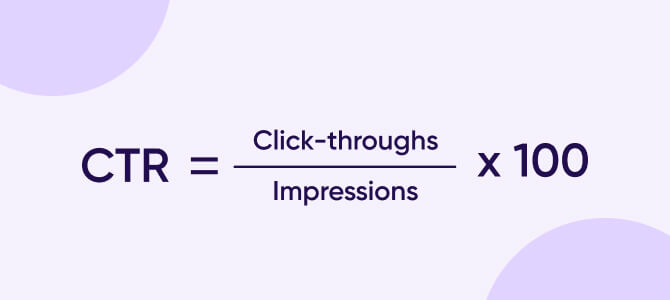Click-through rate (CTR) is a marketing metric that measures how often a link, ad, or email is clicked in relation to how many times it’s shown.
What is click-through rate (CTR)?
Click-through rate is a marketing metric used to measure the effectiveness of a link, ad, or email. It’s calculated by determining the percentage of clicks in relation to impressions (the number of people exposed to that piece of content). In mobile marketing, CTR is the number of clicks on a mobile ad in relation to total views.
Let’s say you see an ad. Like the average person, you can choose to ignore it. Or if it speaks to you, you click it. At the very highest level, this gives an indication to marketers that the ad was effective.
Why is click-through rate important?
CTR is one of the easiest ways to identify your top-performing ads, emails, or links at a glance. It can also show you those that aren’t working so well: a low CTR is a leading indicator of a campaign that may not be targeting the right audience or delivering the right message.
While there’s more nuance to actually determining the true success of a campaign, CTR is a great high-level metric to start measuring the effectiveness of particular creatives.
As a practical example, Google Ads uses CTR as a critical metric when determining the quality score of your ad. The more creative and pertinent the message, the more people will click your ad. And in turn, Google will reward high-quality ads by ranking you higher and lowering your cost per click in the auction.
How is click-through rate measured?
Just follow this fast and easy formula to measure click-through rates:
Example:
Let’s say you’re advertising a mobile game called Fandy Flush. Your Instagram ad receives 1,000 impressions and 100 people click on the ad.
CTR = (100 clicks-throughs / 1,000 impressions) x 100
Your CTR for this campaign is 10%.
CTR benchmarks: what is a good click-through rate?
Measuring CTR is like working out at the gym. There are published averages of how much individuals can benchpress according to age, sex, and weight, for instance, as there are published averages of industry CTRs as well. But what ultimately matters is your personal benchmark (aha — get it?).
Industry averages are ultimately vanity metrics that serve as a baseline if you have no reference point. But if one business’s CTR is a few points higher than yours and their cost-per-acquisition is 10x higher than yours, CTR doesn’t really matter.
So there’s no magic number that determines a good CTR versus a bad one. The only universal truth across niches and industries is that your CTRs should drive profitable results for your specific business.
As we’ve seen, CTR is a very easy and high-level metric that gives you a broad sense of campaign performance. A good click-through rate depends on the medium, channel, and industry you’re focusing on, because it relies on a multitude of factors: competition, budgets, seasonality, and much much more.
Desktop CTR vs mobile CTR: is there a difference?
While the gap is narrowing, mobile and desktop user behavior varies across all marketing channels. 66% of all site visits are now mobile, and according to a recent study, the top five search results on Google averaged 17.16% on desktop and 15.54% on mobile.
Here are a few reasons why there’s a difference:
- Most consumers conduct research on mobile but make purchases (especially big or complex purchases) on desktop PCs.
- Users are more likely to browse for longer periods of time on desktop. The research suggests that the attention span of desktop users has increased by 22 seconds, vs eight seconds on mobile, compared to 2020.
- Consumers use mobile and desktop devices at different times of the day. Desktop usage increases during typical work hours while mobile is used intermittently throughout the day.
The implications of CTR across different channels
Click-through rates help determine the quality and relevance of an advertisement and can affect the cost and performance of an advertising campaign differently in each channel. Some advertising platforms, like Google Ads, use CTR as a factor in determining how prominently an ad is placed, which can help increase visibility and performance.
Here are some of the differences.
CTR in email marketing
Click-through rate in email marketing is calculated in a similar way to other channels. It’s measured as a percentage of the number of times a link, call to action, or image within the email is clicked, in relation to how many times an email was opened and viewed. Email marketers often pair CTR with open rates, bounce rates, and click-to-open rates to measure how effective their email campaigns are.
CTR in search engine optimization (SEO)
Click-through rate in search engine optimization (SEO) is calculated by measuring how many people click on your snippet in the search engine result page (SERP) out of everyone who has viewed it.
Optimizing for CTR does two things. First, it drives more traffic to your website. As a result, it indicates to Google that your snippet is more interesting and relevant than the competition, so they will bump up your search result to show it to more people — helping your overall SEO performance.
You can improve CTR by experimenting with ad copy, optimizing meta descriptions, and using descriptive URLs.
How does CTR weigh up against other marketing metrics?
Like other marketing metrics, CTR doesn’t paint the full picture and should never serve as a sole indicator of success. Metrics like conversion rates, view-through rates, and click-to-open rates may be more effective than CTR in some scenarios.
Let’s dig into each metric related to CTR and walk through when it’s most appropriate to use each one.
CTR vs. conversion rate
Conversion rate measures how many visitors complete an action in relation to the total number of visitors. While that measured action could include clicks, it typically measures metrics tied to revenue, including website registrations, opening an email, making a purchase, or signing up for a giveaway.
That’s not to say CTR and conversion rates aren’t closely related. High click-through rates lead to higher conversion rates, but conversion rates are more goal-specific and thus more insightful when measuring the success of a bottom-of-the-funnel campaign.
CTR vs. view-through rate (VTR)
For video streaming platforms like Netflix and Apple TV, consumers are not inclined to click or engage with the content — they just let the ads play while waiting for their show to start. This is where view-through rate (VTR) is a stronger indicator of success, as it measures the percentage of people who watch an ad from start to finish.
The drawback is that VTR mainly applies to skippable ads — and non-skippable ads naturally have a near 100% completion rate. If a viewer also clicks through your video before the ad is completed, the view will not count towards your VTR.
CTR vs. click-to-open rate (CTOR)
Click-to-open rate (CTOR) is used for email marketing, to measure the ratio of number of clicks to unique opens. This shows how many people engage with an email that they open, which is a better indicator of the quality and relevance of your email.
CTR for emails measures clicks in relation to emails sent — which doesn’t provide much insight into campaign performance.
CTR trends and predictions
CTR for paid search ads has seen an improvement over the years. In 2015, the average CTR was 1.35%, whereas in 2022 it sits at 6-7% for Google search ads. This implies that search ads have become more personalized and relevant over the years (thanks to AI and improved targeting algorithms).
But due to rising privacy concerns and changes in data policy, app marketers will have increasingly limited ways to serve ads to audiences based on interests and behaviors. Instead, the focus will be on improving ad design, experience, copy, and messaging. This major shift will affect CTR for better or for worse, depending on how well marketers can adapt to these changes.
How do you improve and optimize your CTR?
It’s no secret that improving your click-through rates will improve your ad performance and save you money. Here are the strategies you can deploy to improve your CTR today.
Personas, personas, personas
No, you don’t need to know every juicy detail of the marriage status of every person in your audience, nor their deepest and darkest high-school secrets. However, building out personas and ideal customer profiles (ICPs) will give you a data-driven understanding of your audience.
The research you gather on your audience’s interests, challenges, and behaviors will ultimately dictate the quality of your copy and creatives, as well as the strategies you use to reach your ideal users.
Be a blue diamond with your creatives
Whether it’s the advent of Canva or AI tools that generate ad creatives at the click of a button, it’s never been easier to create solid creatives at scale. The tradeoff is that designs are becoming more homogeneous across the board. Investing in truly unique ad creatives that resonate with your audience gives you the opportunity to be a blue diamond in a vast sea of white ones.
Don’t get too fancy: write for your audience
The best ad copy isn’t always the most creative. In fact, your highest-performing ads may seem like the most vanilla thing you’ve ever read. Effective copywriting is rooted in understanding the way your audience reads and speaks.
High-converting copy ultimately solves your audience’s biggest challenges in a simple and understandable way — so don’t get carried away with being too fancy, and always tie it back to your customer.
Test everything!
Improving CTR is no different from any other marketing activity. You need to develop a process that enables you to continuously test and take an iterative approach to improve your campaigns over time. At the end of the day, data will take you much further than purely gut feel.
Frequently asked questions
Click-through rate (CTR) is a marketing metric that shows how often an ad or link is clicked in relation to how many times it’s shown (the number of impressions). This helps marketers to evaluate the effectiveness of a particular campaign or creative, and how well it resonates with the audience.
CTR helps in identifying the performance of ads, emails, or links quickly. This can show you where to invest your budget and where you might need to make changes. It’s crucial for optimizing Google Ads, as a higher CTR can improve your quality score, potentially reducing your cost per click and improving ad ranking.
How do you calculate CTR?
To calculate CTR, divide the number of clicks the ad received by the total impressions, and multiply that by 100. For instance, if an ad gets 100 clicks from 1,000 impressions, the CTR is 10%.
CTR is influenced by multiple factors, and a good one varies by medium, channel, and industry. So, rather than looking to surpass a universal benchmark, you should focus on achieving profitable results tailored to your business needs.
What’s the difference between CTR and conversion rate?
CTR is a high-level metric – it only shows whether someone clicked on a link, and not what happened next. Conversion rate is more specific, focusing on actions directly tied to revenue, like purchases or sign-ups. High CTR can lead to higher conversion rates, but the latter offers deeper insights into campaign success.
How can you improve your CTR?
Improving CTR involves understanding your audience through personas, creating standout ad creatives, writing clear and relatable copy, and continuously testing to refine your approach based on data.
Key takeaways
- Click through rate (CTR) is a marketing metric that measures how often a link, ad, or email is clicked in relation to how many times it’s shown.
- CTR is one of the easiest high-level metrics you can use to identify your top performing ads, emails, or links at a glance, and is most effective when used alongside supplementary marketing metrics.
- Industry CTR benchmarks are a good starting point when you don’t have a reference point. Ultimately, though, an effective CTR is unique to your business and industry.
- Overall, CTR has increased across most advertising platforms due to the improvements in algorithmic matching and AI algorithms. However, we expect to see a change as marketers need to make a shift from behavioral to contextual advertising, focusing on design, experience, copy, and messaging instead of segmenting audiences.
- To improve your CTR, you need to really know your audience and make your ads as relevant and engaging for them as possible, while constantly testing and tweaking for optimum results.








